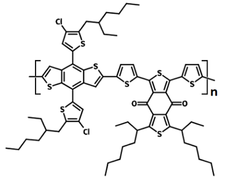PBDB-T-2Cl (also referred to as PCE14) is now available featuring:
- High purity - PBDB-T-2Cl is purified via Soxhlet extraction with acetone, hexane and chlorobenzene under an argon atmosphere
- Large quantity orders - so you can plan your experiments with polymer from the same batch
Pricing
| Batch | Quantity | |
| M2134A1 | 100 mg | |
| M2134A1 | 250 mg | |
| M2134A1 | 500 mg | |
| M2134A1 | 1 g | |
| M2134A1 | 5 g / 10 g* |
|
*for 5 - 10 grams order quantity, the lead time is 4-6 weeks.
Batch details
| Batch | Mw | Mn | PDI | |
| M2134A1 | ≥ 60,000 | ≥ 20,000 | ≤ 3 |
|
General Information
| Full name | Poly[(2,6-(4,8-bis(5-(2-ethylhexyl-3-chloro)thiophen-2-yl)-benzo[1,2-b:4,5-b’]dithiophene))-alt-(5,5-(1’,3’-di-2-thienyl-5’,7’-bis(2-ethylhexyl)benzo[1’,2’-c:4’,5’-c’]dithiophene-4,8-dione)] |
| Synonyms | PCE14, PBDB-T-Cl |
| Chemical formula | (C68H76Cl2O2S8)n |
| CAS number | 2239295-71-5 |
| HOMO / LUMO | HOMO = -5.52 eV, LUMO = -3.57 eV [1] |
| Solubility | Chloroform, chlorobenzene and dichlorobenzene |
| Classification / Family | Organic semiconducting materials, Medium bandgap polymers, Organic photovoltaics, Polymer solar cells, Perovskite solar cells, Hole-transport layer materials, NF-PSCs, All-polymer solar cells (all-PSCs). |

Applications
PBDB-T-2Cl is part of the PBDB-T polymer family. It has a high OPV device performance, with reported efficiencies exceeding 12%. PSCs based on PBDB-T-2Cl as the donor and ITIC-2F as the acceptor have achieved a power conversion efficiency (PCE) of over 14% [2].
Compared to PBDB-T-2F, PBDB-T-2Cl showed slightly lower calculated HOMO levels. This demonstrated that on the BDT (benzodithiophene) backbone unit, chlorine has an even stronger electron-withdrawing ability than fluorine.
Although fluorine has greater electron negativity, it is believed that electron density can be delocalised more effectively to the halogen atom in Th-Cl than in Th-F. Hence, a deeper HOMO energy level is produced.
Usage Details
The device structure of the certified device was:
ITO / ZnO (30 nm) / PBDB-T-2Cl:ITIC-2F (100 nm) / MoO3 (10 nm) / Al (100 nm)
PBDB-T:ITIC-2F solution details:
- Blend ratio: 1:1
- Concentration: 20 mg/ml
- Solvent: Chlorobenzene
- Additive: 1% 1,8-Diiodooctane
Literature and Reviews
- Chlorine substituted 2D-conjugated polymer for high-performance polymer solar cells with 13.1% efficiency via toluene processing, Q. Fan et al., Nano Energy 48, 413–420 (2018); doi: 10.1016/j.nanoen.2018.04.002.
- Over 14% Efficiency in Polymer Solar Cells Enabled by a Chlorinated Polymer Donor, S. Zhang et al., Adv. Mater., 30, 1800868 (2018); DOI: 10.1002/adma.201800868.
- Fluorination vs. chlorination: a case study on high performance organic photovoltaic materials, Y. Zhang et al., Sci. China Chem., 61 (10), 1328–1337 (2018); doi: 10.1007/s11426-018-9260-2.


